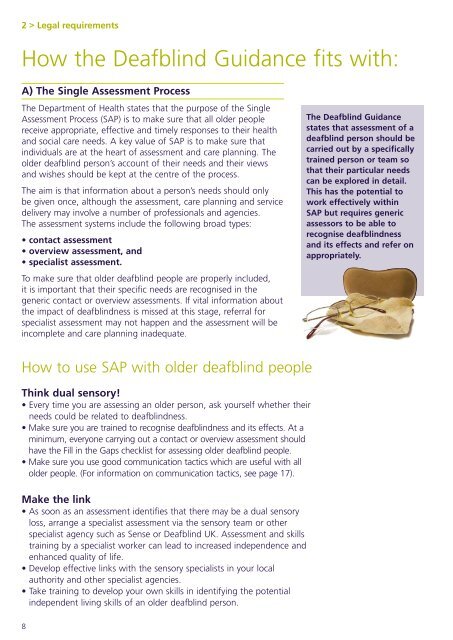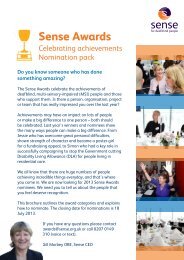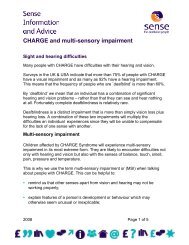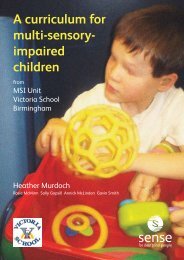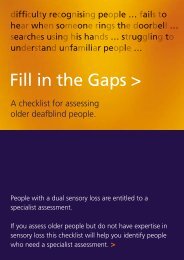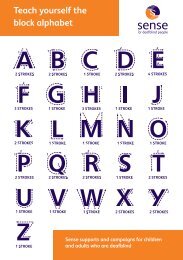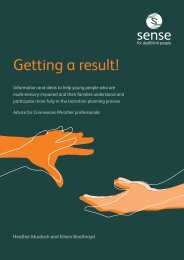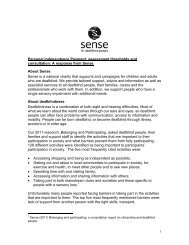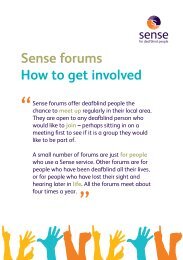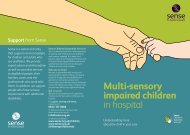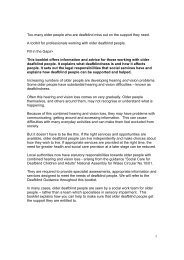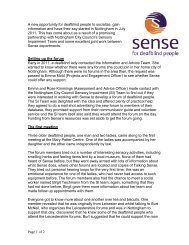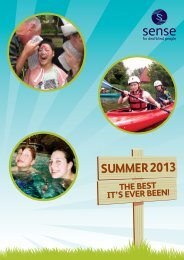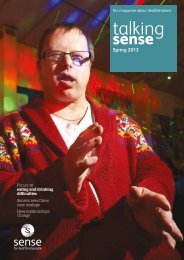Fill in the Gaps > Too many older people who are deafblind ... - Sense
Fill in the Gaps > Too many older people who are deafblind ... - Sense
Fill in the Gaps > Too many older people who are deafblind ... - Sense
Create successful ePaper yourself
Turn your PDF publications into a flip-book with our unique Google optimized e-Paper software.
2 > Legal requirementsHow <strong>the</strong> Deafbl<strong>in</strong>d Guidance fits with:A) The S<strong>in</strong>gle Assessment ProcessThe Department of Health states that <strong>the</strong> purpose of <strong>the</strong> S<strong>in</strong>gleAssessment Process (SAP) is to make sure that all <strong>older</strong> <strong>people</strong>receive appropriate, effective and timely responses to <strong>the</strong>ir healthand social c<strong>are</strong> needs. A key value of SAP is to make sure that<strong>in</strong>dividuals <strong>are</strong> at <strong>the</strong> heart of assessment and c<strong>are</strong> plann<strong>in</strong>g. The<strong>older</strong> deafbl<strong>in</strong>d person’s account of <strong>the</strong>ir needs and <strong>the</strong>ir viewsand wishes should be kept at <strong>the</strong> centre of <strong>the</strong> process.The aim is that <strong>in</strong>formation about a person’s needs should onlybe given once, although <strong>the</strong> assessment, c<strong>are</strong> plann<strong>in</strong>g and servicedelivery may <strong>in</strong>volve a number of professionals and agencies.The assessment systems <strong>in</strong>clude <strong>the</strong> follow<strong>in</strong>g broad types:• contact assessment• overview assessment, and• specialist assessment.To make sure that <strong>older</strong> deafbl<strong>in</strong>d <strong>people</strong> <strong>are</strong> properly <strong>in</strong>cluded,it is important that <strong>the</strong>ir specific needs <strong>are</strong> recognised <strong>in</strong> <strong>the</strong>generic contact or overview assessments. If vital <strong>in</strong>formation about<strong>the</strong> impact of deafbl<strong>in</strong>dness is missed at this stage, referral forspecialist assessment may not happen and <strong>the</strong> assessment will be<strong>in</strong>complete and c<strong>are</strong> plann<strong>in</strong>g <strong>in</strong>adequate.The Deafbl<strong>in</strong>d Guidancestates that assessment of adeafbl<strong>in</strong>d person should becarried out by a specificallytra<strong>in</strong>ed person or team sothat <strong>the</strong>ir particular needscan be explored <strong>in</strong> detail.This has <strong>the</strong> potential towork effectively with<strong>in</strong>SAP but requires genericassessors to be able torecognise deafbl<strong>in</strong>dnessand its effects and refer onappropriately.How to use SAP with <strong>older</strong> deafbl<strong>in</strong>d <strong>people</strong>Th<strong>in</strong>k dual sensory!• Every time you <strong>are</strong> assess<strong>in</strong>g an <strong>older</strong> person, ask yourself whe<strong>the</strong>r <strong>the</strong>irneeds could be related to deafbl<strong>in</strong>dness.• Make sure you <strong>are</strong> tra<strong>in</strong>ed to recognise deafbl<strong>in</strong>dness and its effects. At am<strong>in</strong>imum, everyone carry<strong>in</strong>g out a contact or overview assessment shouldhave <strong>the</strong> <strong>Fill</strong> <strong>in</strong> <strong>the</strong> <strong>Gaps</strong> checklist for assess<strong>in</strong>g <strong>older</strong> deafbl<strong>in</strong>d <strong>people</strong>.• Make sure you use good communication tactics which <strong>are</strong> useful with all<strong>older</strong> <strong>people</strong>. (For <strong>in</strong>formation on communication tactics, see page 17).Make <strong>the</strong> l<strong>in</strong>k• As soon as an assessment identifies that <strong>the</strong>re may be a dual sensoryloss, arrange a specialist assessment via <strong>the</strong> sensory team or o<strong>the</strong>rspecialist agency such as <strong>Sense</strong> or Deafbl<strong>in</strong>d UK. Assessment and skillstra<strong>in</strong><strong>in</strong>g by a specialist worker can lead to <strong>in</strong>creased <strong>in</strong>dependence andenhanced quality of life.• Develop effective l<strong>in</strong>ks with <strong>the</strong> sensory specialists <strong>in</strong> your localauthority and o<strong>the</strong>r specialist agencies.• Take tra<strong>in</strong><strong>in</strong>g to develop your own skills <strong>in</strong> identify<strong>in</strong>g <strong>the</strong> potential<strong>in</strong>dependent liv<strong>in</strong>g skills of an <strong>older</strong> deafbl<strong>in</strong>d person.8


